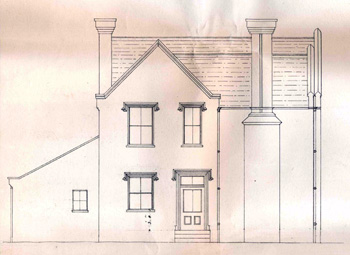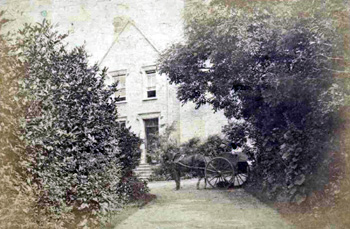
Elevation of Tilsworth Vicarage 1852 [X392/1/1g]
The Rectory of Tilsworth is first mentioned in a document of 1568 [CH92] when it was conveyed by Sir William Skipwith to Gabriel Fowler, Lord of the Manor. At first site this looks like the parsonage house but in reality was not so. The incumbent of Tilsworth was and is a vicar, not a rector. The rector was entitled to receive what were known as the great tithes of his parish and had responsibility for repairing the chancel. In the Middle Ages in some parishes the rector was the parish priest, in others the rector was a religious institution, which then appointed a vicar as agent to conduct services and run the parish, for which he received lesser or vicarial tithes. So the rectory being conveyed here is, in fact, the right to appoint the vicar and receive the great tithes.
In 1604 Richard Fowler leased "that part of the parsonage house of Tilsworth, late in occupation of Thomas Fenn" along with a barn and some land to Richard Theede, yeoman, for six years [CH100]. Unusually, there is no mention of Tilsworth Vicarage in the early 18th century book of descriptions or parsonages made for the episcopal visitations of the Bishop of Lincoln [ABE2]. In the visitations of 1717 and 1720 the Vicar reported that he lived at Houghton Regis and had no curate, indicating that there may have been no vicarage, or that it was leased out to a lay tenant.
The lack of a vicarage seems to have continued into the 19th century. In 1822 a terrier of all church possessions in Tilsworth [FAC35/11] did not note a vicarage, only a cottage 43 feet long and 16 feet wide, with a boarded lean-to barn attached to the west and a garden "in front of the cottage on the north" and an orchard "behind" and "on the south" and bounded east, west and south by meadow land of the Lord of the Manor and north by Stanbridge Road. Licenses were issued in 1841 and 1843 for non-residence of the vicar because there was no parsonage in Tilsworth [P130/0/1-2]

The Vicarage drive about 1880 [P130/28/5/14]
In 1852 a new vicarage was built in Tilsworth, next to the ancient motte called Warren Knoll, north-west of the church. It seems to have been occupied a a Vicarage for less than sixty years. In 1925 the Rating and Valuation Act ordered that every building and piece of land in the country had to be valued to determine the rates to be paid on it. Tilsworth was valued in 1927 and the valuer visiting The Vicarage [DV1/C104/1] found that the occupier was Colonel M. J. E. Fenwick who paid £50 rent per annum since 1924. The house was set in 1.510 acres. The valuer reported: "Saw Colonel Fenwick. Been here 20 years. Water pumped by hand from well. Cesspool drainage. Lighting lamps only. No central heating. Great disadvantage is no water laid on anywhere all over house have to carry water" "Right away from anywhere". Since 1923 Tilsworth had shared a vicar with Stanbridge but clearly had not had a resident clergyman for some time before that.
The house comprised and cellar and, on the ground floor: a small porch; a hall ("passage type stairs go up") measuring 5 feet by 12 feet 6 inches and 8 feet by 6 feet; a dining room measuring 16 feet by 14 feet; a drawing room ("faces south") measuring 14 feet by 17 feet 6 inches; a study measuring 13 feet by 12 feet; "through swing door to" a pantry; a scullery; a larder and a kitchen measuring 12 feet by 14 feet 3 inches. Upstairs were: a W.C.; a double bedroom measuring 16 feet by 11 feet; a bedroom "faces south" measuring 13 feet 6 inches by 17 feet 6 inches and single bedrooms measuring 12 feet 6 inches square and 15 feet by 9 feet. On the second floor was a boxroom and two single attics; the valuer noted a "big slope" to the roof.

The former Vicarage and Warren Knoll December 2008
Outside were: a "good" brick and corrugated iron coal shed; a wood shed; a one bay open fronted shed; a corrugated iron open fronted bicycle shed and a trap shed ("bad"); two wood and brick store sheds; brick and slate fowl houses and a straw shed; two wood, brick and slate earth closets; a brick and slate stables, with two stalls ("keeps horses"); a coach house; a harness room; a brick and slate washhouse; a derelict greenhouse; a tennis court; a kitchen garden and 1.5 acres of grounds. The valuer concluded: "An average little Rectory [sic]". There were also 0.808 acres of orchard with "about ten trees".
Colonel Fenwick had a sad end, as witness this article from the Bedfordshire Times for April 1934: "Lieutenant-Colonel Martyn John Edward Fenwick, J. P., Chairman of the Woburn Division magistrates, and his daughter, Miss Judith Fenwick, a well-known worker in the Women's Institute movement, were found shot just before noon on Monday at their residence, the Old Vicarage, Tilsworth, near Hockliffe. The gardener, Mr. J. Kirby, at work in the grounds, heard two shots from the house, and on going to investigate discovered Miss Fenwick lying at the foor of the stairs leading to Colonel Fenwick's study in a cottage adjoining the Vicarage. She had a gunshot wound in the head. In the study itself the Colonel was found with a gunshot wound through the mouth, and one of his sporting guns lay near by. It appeared that Miss Fenwick had been up to see her father and was returning down the stairs when the tragedy took place"
"Colonel Fenwick was a native of Thurlstone, near Chentenham, and was aged eighty-three. His daughter was fifty. The Colonel was the eldest son of the late Rev. J. E. A. Fenwick, Vicar of Needwood, Staffordshire, and served in the 1st and 2nd Battalions of the Dorset Regiment. He commanded the 11th Provisional Battalion in 1902-3 and was deputy Chief of Public Security, Deputy Inspector General, and a Pasha of Egypt. He was a personal friend of Lord Kitchener and Lord Cromer. While serving in Egypt, he was presented with a tie-pin by the late King Edward [VII] when Prince of Wales for protecting him when an attempt was made on his life. Colonel Fenwick have this pin to his eldest son a few days ago".
"Colonel Fenwick was very popular with his fellow county magistrates and was most conscientious in his magisterial duties. He was appointed to the Commission of the Peace for the County of Bedford at the Midsummer Quarter Sessions 1918 and he was elected Chairman of the Woburn Bench in 1921. He was most regular in his attendance at Quarter Sessions and at the Standing Joint Committee".
"Colonel Fenwick leaves two sons, Mr. Alan Fenwick and Captain Fenwick. Mrs. Fenwick died in 1919".
"The inquest was opened at the Vicarage on Tuesday by the District Coroner, Mr. G. J. M. Whyley. The bodies were identified by Colonel Fenwick's son, Mr. Alan Fenwick, of London. Dr. W. H. Square, of Leighton Buzzard, gave medical evidence and said that Colonel Fenwick had been worried about how his daughter would get on after his death. Lately he had been rather run down, chiefly owing to his age".
"The inquest was adjourned until Monday afternoon. The funerals, after cremation, will take place to-day at Leckhampton near Cheltenham".
The following week the newspaper reported on the resumed inquest: "The inquest was resumed at Tilsworth Vicarage on Monday afternoon. The District Coroner, Mr. G. J. M. Whyley, who sat with a jury, said that Colonel Fenwick was a distinguished soldier and he continued, after his retirement, to do useful work in the service of his country. Their task was a very easy one, though distasteful to perform".
"Miss Irene Hull, a cook employed at the Vicarage, said that when she took up Colonel Fenwick's hot water he was lying on his bed. He said to her "Something dreadful is going to happen before very long. When it does happen it will be dreadful". He seemed upset about Miss Fenwick and said he left very sorry for her. Witness added that she could not have had a better master".
"Miss Constance Emily Mary Warren, parlourmaid, said that about 11 a.m. she saw Colonel Fenwick and Miss Fenwick on the landing apparently having a normal conversation".
"Mr. Arthur H. Kirby, groom gardener, described how he heard two shots, which seemed to come from the room over the harness-room. He then found Miss Fenwick lying at the bottom of the stairs".
"Inspector A. H. Weedon, of Woburn, said by Miss Fenwick's body lay a white Ensign with one corner over her shoulder. It looked as if it had falledn from the wall. In the room above he found Colonel Fenwick lying on his back on the floor and by his side was a double-barrelled gun".
"The jury returned a verdict that Miss Fenwick was murdered and that Colonel Fenwick committed suicide whilst temporarily insane".
"The Bishop of Saint Albans visited Tilsworth on Sunday morning and preached the sermon at the Parish Church. Amongst those present were Mr. A. T. Lennox-Boyd, M. P. and Mr. A. H. Wingfield".
"The Bishop said that Colonel fenwick was a gallant English gentleman, a faithful and devoted Christian and a true friend to everyone, not least to those who were his neighbours. When there was this ghastly happening at the end of so long and honourable a life the human heart cried out to God to ask why it should be allowed to happen. Yet, in the face of such suffering and pain, they were shown the way to strengthen their faith in Him".
The house today [2009] is not a vicarage. For some years it was called Tilsworth House. At the time of writing [2008] it is now called Orchard Lodge, a privately run care home for the elderly.